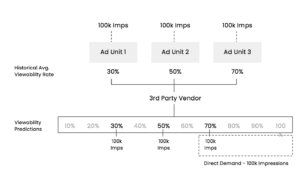Programmatic viewability – you can do better
By Asaf Shamly | February 26, 2021

Here’s a fun fact: your programmatic viewability could be doing a lot better and you know it.
You’d love to squeeze in a little extra juice out of it, but with direct campaigns and the promise of at least 70% viewability hanging over your head, most of your time is spent optimizing those campaigns towards high viewability.
So, while you’re juggling direct ads from one placement to another, chasing the elusive 70% viewability (and doing a dozen other tweaks on a daily basis), you’re most likely wasting too many ad impressions – impressions that you could have leveraged programmatically.
You’re probably leaving your programmatic demand on autopilot, or worse – sometimes removing demand partners that are outbidding advertisers you need to deliver to first.
Let’s go on a short but wild ride, and we’ll show you how you can make the most of your programmatic campaigns by optimizing the viewability of your entire ad inventory.
How poor viewability hurts programmatic performance
We’ll explain via an example.
Let’s say you have an article with 100K visits and three ad units on that page. That means each ad unit has 100K impressions to sell. Typically, when analyzing historical data, of the three ad units, one will have 30% viewability, another 50%, and the final one – 70%.

Now, let’s assume you’re managing a direct campaign and the advertiser expects at least 70% viewability (that’s the golden standard, after all). That means you can only start selling directly into ad unit 3, without wasting ad impressions.
That being said, based on the info at your disposal, you only have 70K viewable impressions to sell (100K impressions on ad unit 3 with 70% viewability → 70K viewable impression).
The first problem that rears its ugly head here is that you’re relying on historical data. After the campaign launches, you’ll go into the ad server and look for the ad units that have had the highest viewability in the last few hours, then go ahead and move your campaign to those units. For example, if ad unit 2 suddenly presents a 70% viewability rate – you’ll quickly do the footwork of selling ads into it, as well.
The second problem to rear its (even uglier) head is, if you promised a certain number of viewable impressions or guaranteed specific viewability rate in a certain timeframe, and your best-performing ad units still can’t deliver, you’ll have to compensate by spending (well, basically wasting) impressions from other ad positions to deliver these viewable impressions
The non-viewed impressions are ones you won’t be getting paid for. Impressions which you could have spent better through programmatic.
You’re running around, chasing viewability, wasting both impressions and your time, and for what? To only hit the minimum requirement for a successful campaign. Hardly something to be super excited about.
But you can do something about it.
Rising tide lifts all viewability boats

The premise is simple – once your entire inventory is optimized for maximum viewability, your eCPMs, CTRs and fill rates will increase. Simply putting it – your programmatic performance will directly improve (see what we did there?).Do that, and suddenly your programmatic ads are no longer the neglected child that underperforms, but a great asset that generates a hefty portion of your income.
Let’s review the best practices top publishers regularly deploy, as well as new and emerging solutions they’re opting for that are showing great promise and results.
We can divide them in three categories:
- before the page loads
- after the page loads
- while the page loads
Before loading
A/B testing placements
Publishers will A/B test various ad sizes and placements until they find a winning combination. It’s relatively hard to move the needle with this approach, so they tend to deploy it continually. As soon as they find a better-performing format, they’ll deploy it and start A/B testing it against a different placement layout.
Using sticky placements
A high risk – high reward play. Easy to implement and offers higher viewability rates, but sticking around in the visitor’s view most of the time could piss off a few of them, so tread lightly.
After loading
Lazy loading
Usually deployed for ad placements below the fold, it allows publishers to improve their viewability rates by basically initiating gradual rendering of ads. However, this generalizes user behavior and overlooks scenarios when, for example, someone opens the page and directly scrolls. If the user skimmed quickly and went back up, the impression is wasted.
Lazy loading results in a loss of between 25%-30%% impressions, all depending on your viewability rate before lazy loading
For this reason, it’s usually considered a last resort, but it’s the second most popular approach for ad viewability improvements, with more than half (57%) of publishers opting for it.
In-View Ad refresh
Many publishers are resorting to the ad refresh technique because it sounds like a solution straight from heaven: it can bring higher ad revenues per session, increase viewability rates and be easy to implement. However implementing in-view refresh should be done carefully, making sure refreshed ads do not shift the page layout causing high CLS (cumulative layout shift) changes and bad UX for your users. In addition – some advertisers (SSPs / Exchanges) have different refresh standards – if you will not follow, you might actually lose money.
During loading
Asynchronous loading
With synchronous loading, things like header bidding can prevent the entire page from loading as fast as it could be. And a slow-loading page can wreak havoc on not just ad viewability, but the performance of your ad inventory in general.
Unleashing AI behind the ad inventory
If you thought making any real-time data driven changes to your ad campaign’s behavior while the page is loading is impossible – we’re not going to blame you. It does sound impossible – for a human.
But a machine, and an Artificial Intelligence (AI) one at that can do it, and then some – without breaking a virtual sweat.
By using hundreds of anonymized data points, AI solutions can personalize the ad layout for each individual visitor, in real-time, during the milliseconds the page is loading.
This improves viewability rates by hundreds of percent, helps maximize the ad inventory and reduces ad waste that can be leveraged programmatically.
Closing comments
Nowadays, publishers spend a hefty portion of their time doing all kinds of manual efforts, all with the goal of reaching at least 70% viewability on direct campaigns.
With this golden standard often proving a tough nut to crack for most of their ad inventory, publishers end up wasting thousands of impressions that could have been better leveraged through programmatic.
With a few best practices and some AI magic, publishers can create, optimize and personalize their ad inventory – maximizing viewability across the board and as a direct result, reaping the fruits of their new and improved programmatic viewability.
Latest Articles
-

What Sales Got Right About Competitive Intelligence – and Why It’s Time for Advertisers to Catch Up
In sales, competitive intelligence became second nature — the reason teams know why deals were won or lost. Advertisers, on the other hand, are still optimizing in the dark. It’s time to bring the same discipline to marketing, and finally see beyond surface-level metrics.
View Now -

AI is Rewriting the Attention Economy, Advertisers are at Risk of Getting Sidelined
AI is rewriting the attention economy. Perplexity’s “citations, not clicks” payouts and Cloudflare’s pay-per-crawl model mark a new phase where platforms set the rules of visibility. Unless brands and agencies demand clarity, control, and real behavioral signals, performance will be optimized to interfaces, not outcomes.
View Now -

When Agentic AI Takes the Wheel, Who’s Watching the Road?
Speed feels like smarts in advertising, but most “autonomous” systems optimize on labels and averages rather than behavior in context. They can’t see scroll, true in-view time, ad density, or what happens after the impression. Data without depth is a liability; the edge now is first-party, behavior-rich signals learned across environments.
View Now
